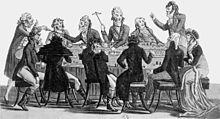Roulette Laws
As roulette laws refers to the following laws that in the random sequences of numbers appearing in roulette or chance pairs such as Rouge and Noir occur.
The Laws of Equilibrium (Equilibre) and Deviations (Ecarts)
According to the law of large numbers , on a long-term average, all 37 numbers occur with the same relative frequency of 1/37 = 2.7% (so-called relative compensation ); This fact leads many players to the wrong conclusion that in a sufficiently large series of games each number occurs exactly the same number of times ( absolute equalization , equilibrium ).
If one considers a random sequence that results from the occurrence of a pair of simple chances such as Rouge - Noir (or also Pair - Impair and Manque - Passe ), whereby coups in which the ball falls on Zéro are not counted, then a random sequence results as can also be obtained by flipping a fair coin . In order not to always have to use the addition “without taking Zéro into account ”, series of coin tosses are always considered below.
For an infinite series of coin tosses, according to the law of large numbers , the long-term mean that heads and tails each occur with the same relative frequency of 50%.
As the number of throws increases, the empirical frequency (i.e. the quotient of the number of throws with a heads result by the total number of throws) approaches the value of 1/2 given by the probability, but this does not mean that the Relative compensation also entails absolute compensation at a certain predetermined point in time - rather the opposite is true: the expected value of the absolute deviation ( Écart ) at a certain given point in time increases with the number of spins and tends towards infinity.
Although the probability of an absolute equalization after a fixed number of games determined in advance, the greater the number in question is chosen (and tends towards zero), nevertheless, with probability one, an absolute equalization occurs at some point (so-called zero -Recurrence of the symmetrical random walk on ) - however, it is mathematically pointless to wait for the absolute balance, as the expected value of the waiting time for the return to the so-called zero line is infinitely large. This result seems downright paradoxical when you consider that an absolute equalization with probability 1/2 already occurs after two games.
In the course of an infinite sequence of coin flips, there is an infinite number of times of absolute equalization ( zero recurrences ) with probability one , the intermediate times ( ecart lengths ) are not limited, their expected value is infinitely large; the same applies to the Ecart summit , i. H. the amounts of the greatest deviations from the zero line.
It goes without saying that these results cannot be used to construct winning strategies: An equalizer who hopes for a reduction in the absolute deviation from the mean naturally has the same chance of winning as a player who relies on an increase in the existing deviation (see also Marche ) .
The laws of characters and series
If you divide an infinite series of coin tosses ( permanence ) into equally long sections ( grid ) of z. If, for example, throws are thrown in each case , a total of different patterns ( figures ) are possible: According to the law of large numbers , all these figures appear with the same relative frequency of .
If you break down a permanence into sections of four coups each and combine the complementary figures (such as KZKK and ZKZZ ), you get the eight Alyettian figures :
- KKKK and ZZZZ
- ZKKK and KZZZ
- KZKK and ZKZZ
- ZZKK and KKZZ
- KKZK and ZZKZ
- ZKZK and KZKZ
- KZZK and ZKKZ
- ZZZK and KKKZ
which occur on average with the same relative frequency of 1/8 = 12.5%.
If one breaks up an infinite sequence of coin tosses not into sections of equal length, but into series of head and series of tails, the relative frequency of the lengths of the individual series follows the geometric distribution with the parameter ; d. H.
- 50% of the series have a length of one ( one series are also referred to as intermittency )
- 25% of the series are two in length
- 12.5% of the series are three in length
- 6.25% of the series are four and so on.
The mean waiting time before a series of e.g. B. Head-throws are throws.
The law of infinity of permanence
If you select a partial sequence from an infinite sequence of coin flips or roulette numbers, e.g. For example, if one only considers coups nos. 1., 3., 5., 7., 9., ..., this new random sequence has the same properties as the original sequence; d. H. the same statements apply again with regard to
- of the absolute and relative compensation (Equilibre) and the deviations (Ecarts)
- the appearance of characters and series, as well as
- the two-thirds law for the occurrence of the individual numbers.
In particular, it is irrelevant for the generation of a random sequence whether the numbers are written down in consecutive order on the same table, or whether one does not write down a few coups in between and continue the sequence with the numbers of another table. This is a direct consequence of the fact that the individual tosses of a coin or roulette ball are stochastically independent of one another .
The two-thirds law
Main article Two thirds law







